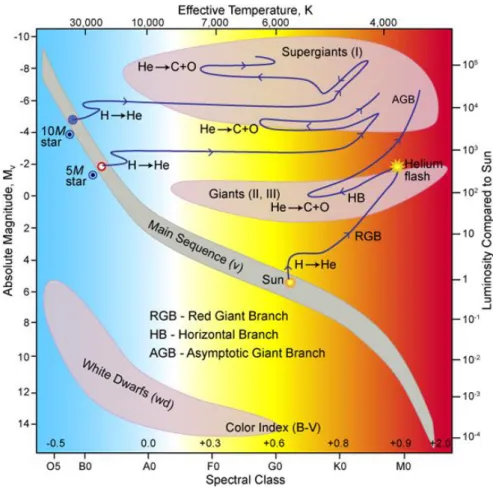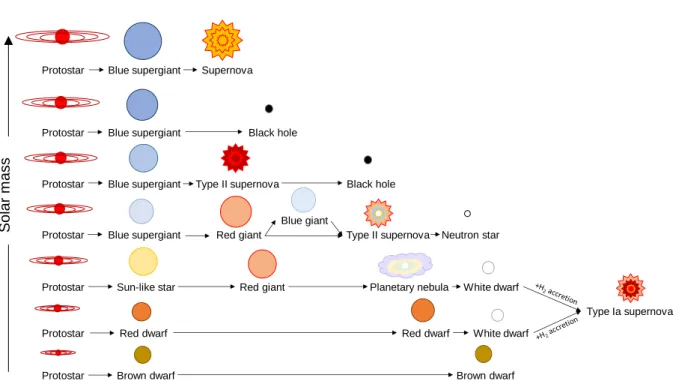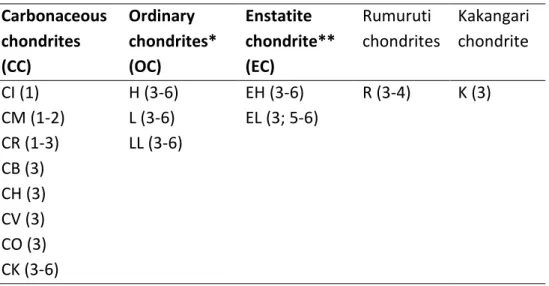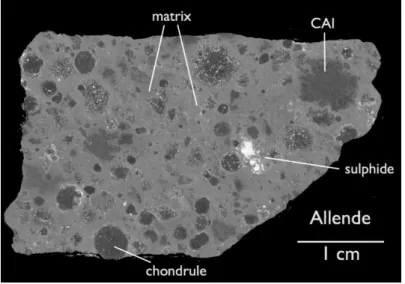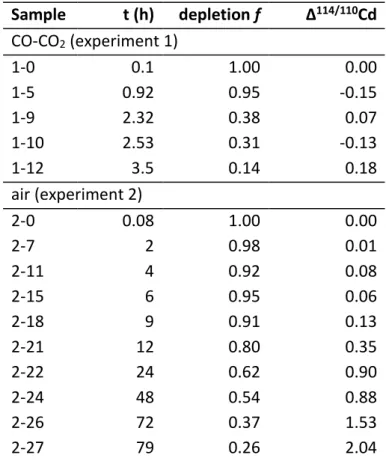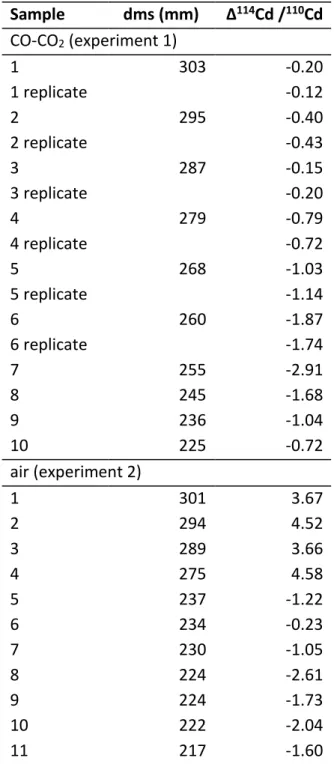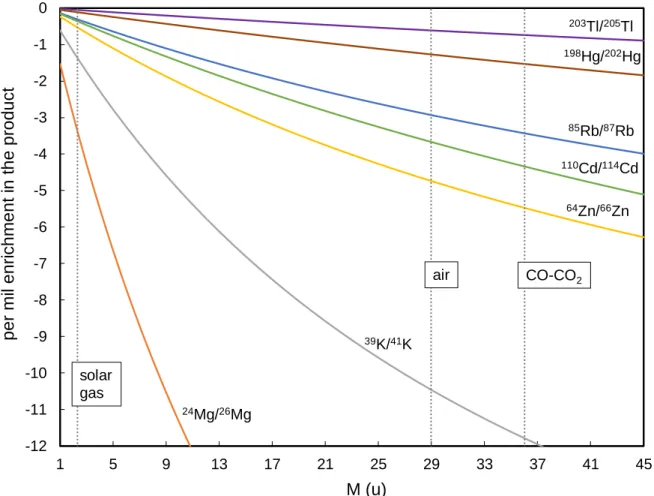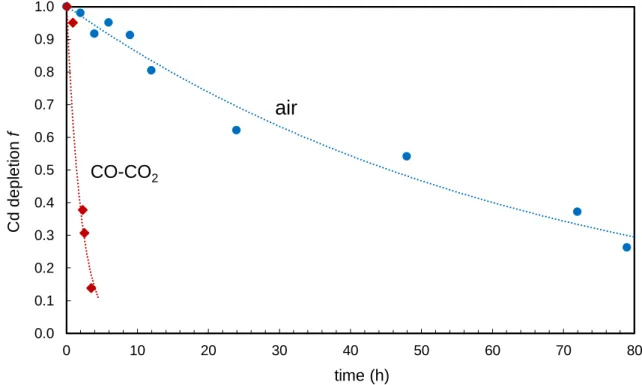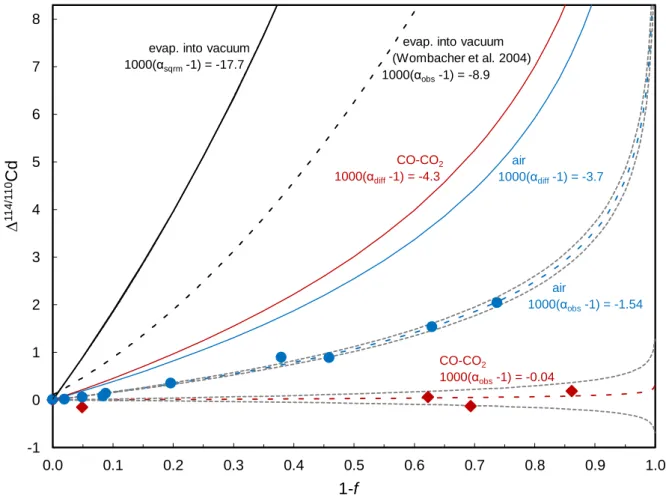Advances in Cd and Fe isotope cosmochemistry
I n a u g u r a l - D i s s e r t a t i o n zur
Erlangung des Doktorgrades
der Mathematisch-Naturwissenschaftlichen Fakultät der Universität zu Köln
vorgelegt von
Victoria Elisabeth Zippmann aus Eisenstadt
Köln, 2019
Advances in Cd and Fe isotope cosmochemistry
I n a u g u r a l - D i s s e r t a t i o n zur
Erlangung des Doktorgrades
der Mathematisch-Naturwissenschaftlichen Fakultät der Universität zu Köln
vorgelegt von
Victoria Elisabeth Zippmann aus Eisenstadt
Köln, 2019
Dr. Daniel Herwartz
Tag der mündlichen Prüfung: 29.04.2019
“WITH YOUR MIND POWER, YOUR DETERMINATION, YOUR INSTINCT, AND THE EXPERIENCE AS WELL, YOU CAN FLY VERY HIGH.”
― Ayrton Senna
Abstract ... 4
Kurzzusammenfassung ... 6
I. Introduction ... 8
1. Evolution of a star and the synthesis of elements ... 9
1.1.Star formation ... 9
1.2. Stellar evolution and burning stages ... 10
2. Formation of the Solar system ... 12
3. Chondrites and their components ... 15
3.1. Chondrules ... 16
3.2. Refractory Inclusions ... 17
3.3. Matrix ... 18
3.4. Presolar grains ... 18
4. Summary and outlook ... 19
II. Cadmium stable isotope fractionation during evaporation and condensation at atmospheric pressure ... 22
1. Introduction ... 23
2. Experimental Setup and MEthods ... 24
2.1. Evaporation and recondensation experiments ... 24
2.2. Sample preparation ... 25
2.3. Elemental and isotope analyses ... 25
3. Theory ... 28
4. Results ... 34
4.1.Cadmium loss and isotope fractionation in silicate melt residues ... 34
4.2. Condensation plates and Rayleigh condensation model ... 36
5. Discussion ... 39
5.1.Isotope fractionation during evaporation ... 39
5.2.Cadmium isotope fractionation due to diffusion and condensation ... 40
6. Conclusion ... 41
III. Homogeneous iron isotope composition of chondrites and
Earth ... 43
1. Introduction ... 44
1.1.The formation of the elements and isotopes ... 44
1.1.1.Nucleosynthesis in massive stars and core-collapse supernova (Type II supernova) ... 46
1.1.2.Nucleosynthesis in binary systems with white dwarfs (Type Ia supernova) .. 48
1.1.3.Nucleosynthesis in AGB stars ... 48
1.2.Nucleosynthetic anomalies of Fe-peak element isotopes in solar system materials 49 1.2.1.Iron isotopes ... 52
1.2.2.Titanium isotopes ... 54
1.2.3.Chromium isotopes ... 57
1.2.4.Nickel isotopes ... 59
2. Methods ... 62
2.1.Leaching and sample preparation ... 62
2.2.Iron separation via column chemistry ... 64
2.3.Mass spectrometry ... 64
3. Results ... 69
3.1.Iron fractions in the leachates and residues ... 69
3.2.Stable Fe isotope compositions ... 70
3.3.Mass-independent Fe isotope variations ... 71
1.2.5.µ56/54Fe(57/54) ... 72
1.2.6.µ58/54Fe(57/54) ... 72
4. Discussion ... 79
4.1.Mass-dependent Fe isotope fractionation in leachates and residues ... 79
4.2.Mass-independent (nucleosynthetic) Fe isotope compositions: Homogeneous iron vs. dichotomy of Fe-peak element isotopes ... 79
4.3.Theory I: Redistribution of carrier phases ... 81
4.4.Theory II: Injection and heterogeneous distribution of anomalous presolar dust ... 81
5. Conclusion ... 83
References ... 84
Appendix ... 95
Acknowledgements ... 107
Erklärung ... 108
Lebenslauf... 109
Abstract
The question about how our solar system was formed is central in cosmochemistry. Within this thesis, I follow two different approaches that relate to this central question. First, mass- dependent Cd stable isotope fractionation was studied experimentally in order to improve our understanding of the stable isotope fractionation effects associated with evaporation and condensation processes. A thorough understanding of such stable isotope effects is required to interpret natural variations, for example in meteorites. Second, Fe isotope compositions were studied in chondrite leachates and residues at high precision in order to reveal potential isotope heterogeneities due to the uneven distribution of materials with different stellar origins within chondrite samples as well as on the planetary scale.
To investigate volatile element stable isotope effects related to evaporation and condensation under reduced and oxidized conditions, two experiments were implemented, experiment 1 in CO-CO2 and experiment 2 in air. Samples were taken from evaporating silicate melts at the bottom of a furnace tube and from plates placed on the furnace wall where Cd vapor recondensed. Cadmium was separated from evaporation and condensation samples and analyzed using MC-ICPMS. For 114Cd/110Cd measurement precision (2 s.d.) was ±0.03 ‰.
Results show that the loss of volatile elements during evaporation can proceed with neglectable isotope fractionation under reduced conditions. It is assumed that in experiment 1, the isotope fractionation is suppressed by a saturated boundary layer on top of the melt surface. Back reaction of evaporated material with the melt occurs and equilibrated material evaporates from the layer. Samples leached from condensation plates reveal an enrichment of light Cd isotopes closer to the melt surface and an enrichment of heavier Cd isotopes at the top of the plates. As expected from their higher collision frequency due to their higher velocity, the light Cd isotopes condensed preferentially. In experiment 2, the fractionation factor is in good agreement with what is expected from purely kinetic condensation. In experiment 1, it is likely that back reaction altered the fractionation.
Deviations from terrestrial isotope ratios in solar system materials such as meteorites are called nucleosynthetic anomalies and can be detected via high-precision isotope analyses Since Fe isotope measurements increased in precision over the last decades, high-precision MC-ICP-MS Fe isotope analyses of chondritic material were implemented in this thesis. Leachates and residues of six different bulk chondrites and bulk rock samples were analyzed for their Fe
isotope composition with a measurement precision (2 s.d.) of 13 ppm for 56Fe/54Fe and 16 ppm for 58Fe/54Fe. No nucleosynthetic Fe isotope anomalies were found in the analyzed samples. In contrast to homogenous Fe, other Fe-peak elements like Cr or Ti show nucleosynthetic anomalies on the bulk rock scale and planetary scale. Theories to explain this phenomenon are 1) secondary redistribution of anomalous refractory Fe-peak element carrier phases beside less refractory Fe carrier phases which could not survive high-temperature events and got homogenously mixed throughout the solar system as gas, or 2) an initially homogeneous molecular cloud or protosolar disk into which anomalous material was injected and heterogeneously distributed, while Fe is carried by thermally unstable phases that evaporated and mixed homogeneously throughout the solar system. A small amount of anomalous Fe in rare grains survived high-temperature events but cannot be detected on bulk rock scale due to the mass budget of Fe in the solar system.
Kurzzusammenfassung
Eine zentrale Frage in der Kosmochemie ist die, nach der Entstehung unseres Sonnensystems.
In dieser Arbeit zeige ich zwei verschiedene Herangehensweisen auf, die sich auf diese zentrale Frage beziehen. Zuerst wurden massenabhängige stabile Cd-Isotopenfraktionierungen experimentell untersucht, um ein besseres Verständnis für die Fraktionierung stabiler Isotope in Verbindung mit Verdampfung und Kondensation zu erlangen. Ein umfassendes Verständnis für diese Isotopeneffekte ist notwendig um natürliche Variationen, wie zum Beispiel in Meteoriten, zu interpretieren. Als zweites wurden hoch-präzise Analysen der Fe- Isotopenzusammensetzungen von Säureauszügen und Residuen von Chondriten untersucht, um potenzielle Isotopen-Heterogenitäten aufgrund von ungleicher Verteilung von Material mit unterschiedlicher stellarer Herkunft in Chondrit-Proben und auf planetarer Ebene zu beleuchten.
Um die Effekte in stabilen Isotopen flüchtiger Elemente bei Verdampfung und Kondensation unter reduzierenden und oxidierenden Bedingungen untersuchen zu können, wurden zwei Experimente durchgeführt, Experiment 1 in CO-CO2 und Experiment 2 in Luft. Es wurden abdampfende Silikatschmelzen, die am Boden eines Rohrofen platziert waren, und an der Ofenwandung platzierte Kondensationsplatten beprobt, an welchen Cadmiumdampf kondensiert ist. Cadmium wurde von den Schmelzproben sowie den Kondensaten chemisch abgetrennt und mittels MC-ICP-MS analysiert. Für 114Cd/110Cd wurde eine Messgenauigkeit (2 s.d.) von ±0.03 ‰ erreicht. Die Ergebnisse zeigen, dass der Verlust flüchtiger Elemente durch Verdampfung in reduzierendem Gas mit nur vernachlässigbar geringer Isotopenfraktionierung auftreten kann. Es wird angenommen, dass die Isotopenfraktionierung in Experiment 1 durch eine Cd-Dampf gesättigte Grenzschicht auf der Oberfläche der Schmelze unterdrückt wird. Die mit Säure aus den Kondensationsplatten geätzten Proben zeigen eine Anreicherung von leichten Cd-Isotopen nahe der Schmelzoberfläche und eine Anreicherung von schweren Cd-Isotopen am oberen Ende der Platten. Aufgrund der höheren Geschwindigkeit der leichten Isotope ist ihre Kollisionsfrequenz höher und sie kondensieren somit bevorzugt.
Der Fraktionierungsfaktor aus Experiment 2 zeigt eine rein kinetische Kondensation an. In Experiment 1 verringern vermutlich Rückreaktionen die Isotopenfraktionierung.
Deutliche massenunabhängige Abweichungen von terrestrischen Isotopenverhältnissen in Materialien des Sonnensystems, wie zum Beispiel Meteoriten, werden als nukleosynthetische
Anomalien bezeichnet und können über hochpräzise Isotopenanalysen nachgewiesen werden.
Da die Fe-Isotopenanalyse in den letzten Jahrzehnten an Präzision gewann, wurden in dieser Arbeit hochpräzise MC-ICP-MS Fe-Isotopenanalysen an chondritischem Material durchgeführt. Es wurde die Fe-Isotopie von Säureauszügen und Residuen von sechs verschiedenen Chondriten und Gesamtgesteinsproben analysiert und dabei eine Messgenauigkeit (2 s.d.) von 13 ppm für µ56Fe/54Fe und 16 ppm für µ58Fe/54Fe erreicht. In den untersuchten Proben konnten keine nukleosynthetischen Fe-Isotopenanomalien nachgewiesen werden. Andere Fe-Peak Elemente wie Cr oder Ti weisen, im Gegensatz zum homogenen Fe, sowohl auf der Gesamtgesteinsebene als auch auf planetarer Ebene nukleosynthetische Isotopenanomalien auf. Theorien zur Erklärung dieses Phänomens sind 1) die sekundäre Umverteilung von isotopisch anomalen refraktären Fe-Peak Element-Trägerphasen, während weniger refraktäre Fe-Trägerphasen Hochtemperaturereignisse nicht überstehen konnten und in der Gasphase homogen im Sonnensystem verteilt wurden, oder 2) eine initial homogene Molekülwolke oder protosolare Scheibe, in welche isotopisch abweichendes Material eingebracht und heterogen verteilt wurde. Dieses anomale Material müsste an Fe verarmt sein um aufgrund des Fe-Massenbudgets nicht im Sonnensystem nachweißbar zu sein, oder es wäre in thermisch unstabilen Phasen gebunden, die während Hochtemperaturphasen verdampften und homogen im Sonnensystem verteilt wurden.
I. Introduction
1. EVOLUTION OF A STAR AND THE SYNTHESIS OF ELEMENTS
1.1. Star formation
In the interstellar medium (ISM), cold areas (~7-15 K) of gas and dust, with densities that exceed the point where the formation of molecules is possible (~103 – 105 mol cm-3), are called molecular clouds. They mainly consist of molecular hydrogen, helium and molecules like CO (Boss and Ciesla, 2013). Areas with the highest densities in these clouds represent the earliest evolutionary stage of a stellar system (Alexander, 2001). Materials in the ISM from which the solar system formed are assemblages of debris from different stars born in different molecular clouds at different times (Busso et al., 1999). High-density regions in molecular clouds are the only place in the universe where stars can be formed. When the mass of the dense region reaches the Jeans mass (Jeans, 1902), which is a certain value depending on temperature and density, the hydrostatic equilibrium becomes unstable. The potential energy of the gravitational force exceeds the kinetic energy of the internal gas pressure hence the cloud undergoes gravitational collapse. Also, compression of dense molecular cloud regions due to cloud collisions or shock waves from nearby supernova explosions can trigger a molecular cloud collapse.
A rotating core, that evolves towards hydrostatic equilibrium, arises which represents the first stage of a protostar and is surrounded by a dense accretion disc (McSween and Huss, 2010).
The newly formed young protostar has an initial size of about 1-10 AU and accretes infalling material while its temperature increases (Boss and Ciesla, 2013; Goodwin, 2013). Processes within the accretion disk and ejection of material from the protostar via bipolar outflows (jets) are mechanisms by which angular momentum is removed from the system, aiding accretion of the protostar (McSween and Huss, 2010). Thermal energy prevents a collapse of the protostar due to its mass and density (Goodwin, 2013). When the core temperature reaches ~ 2000 K, enough energy is available to dissociate molecular hydrogen. The temperature drops and causes a rapid collapse of the protostar to stellar density. Further dissociation of all molecular hydrogen, further accretion of surrounding cloud material and an increasing central density and temperature due to contraction leads to ignition of hydrogen fusion reactions and completes the formation of the star. This path does not apply for brown dwarfs. They can only reach a mass of ≥ 0.8 M☉ and are unable to ignite the nuclear fusion of hydrogen.
1.2. Stellar evolution and burning stages
The mass of a star determines its evolutionary path and life span. After the ignition of hydrogen burning in the core, the star joins the main sequence of the Hertzsprung-Russell diagram (HRD) (Figure 1.1, Australia Telescope National Facility, n.d.).
Figure 1.1. Hertzsprung-Russell diagram showing the post-main sequence evolutionary tracks of stars with 10 M☉, 5 M☉ and 1 M☉. The fusion of H into He in the core is the first burning stage of a star. It is dependent on solar mass, how far a star can evolve before its life ends. Figure taken from Australia Telescope National Facility (n.d.).
Due to the ignition of nuclear fusion of hydrogen, helium is produced from the reaction of four hydrogen atoms to form 4He. This fusion reaction is exothermic and represents the main source of nuclear energy in the Sun (McSween and Huss, 2010). When all hydrogen in the star’s core is fused to helium, thus exhausted, the core contracts and heats up due to compression. This leads to a further hydrogen fusion in the zone around the helium core and establishes a burning shell around the hydrogen-depleted core. Due to increasing thermal pressure the shell expands, cools on the outside, and turns the star into a red giant. Due to a rising core temperature, helium fusion ignites, further contraction stops and the balance between thermal pressure and
gravitational compression is established again. Three 4He atoms (α-particles) react to 12C (and four to 16O) in the core until exhaustion of helium. A star with a solar mass < ~10 M☉ evolves to an AGB star, undergoes the process described in chapter II/3.1.3. and ends up as a white dwarf (Figure 1.2, NASA Jet Propulsion Laboratory (n.d.)). If the star has a mass > ~10 M☉, the process of contraction and heating, as described above, reoccurs including a new 4He- burning shell. Subsequently, fusion of 12C ignites, resulting in 24Mg, 20Ne and 16O production in the core. This burning stage lasts until exhaustion of carbon and the formation of another burning shell from products produced outside the core. It follows the Ne-burning stage where mainly 28Si, 16O and 24Mg are produced. Then oxygen reacts with itself during the O-burning stage, producing 28Si and 32S. In the final burning stage, main nucleosynthesis is driven by photodisintegration which ejects α-particles, protons and neutrons from stable nuclei. Free particles are then consumed by the production of various nuclei up to the mass of iron. Nuclei much heavier than iron cannot be produced via exothermic fusion reactions. The Si-burning stage lasts about one day until the star’s life ends due to disintegration of iron in the core followed by a core collapse which induces a shock wave. The result is a supernova that ejects material into the interstellar medium (ISM). Depending on the initial stellar mass, a black hole, a neutron star or only gas and dust without a remnant remains after the explosion (Figure 1.2) (see chapter II/1.1).
Figure 1.2. Evolution of a star depending on its solar mass. Graphic adapted and redrawn after NASA Jet Propulsion Laboratory (n.d.).
Protostar Blue supergiant Supernova
Protostar Blue supergiant Black hole
Protostar Blue supergiant Type II supernova Black hole
Protostar Blue supergiant Red giant Type II supernova Neutron star
Protostar Sun-like star Red giant Planetary nebula White dwarf
Protostar Red dwarf Red dwarf White dwarf
Protostar Brown dwarf Brown dwarf
Blue giant
Type Ia supernova
Solar mass
2. FORMATION OF THE SOLAR SYSTEM
Our solar system (Figure 1.3 after Shipman et al. (2012)) formed 4.57 Ga years ago (Scherstén et al., 2006; Bouvier and Wadhwa, 2010) from the rotating accretion disk consisting of dust and gas that surrounded a protostar which evolved to our sun (Boss and Ciesla, 2013).
Figure 1.3. Solar system objects with their distance to the sun to scale using data by Shipman et al. (2012).
1 AU = 149597801,7 km (International Astronomical Union, 2012)
The protosolar accretion disk underwent a thermodynamical and cosmochemical evolution which is not fully understood to this day due to complex chemical and physical observations in solar material that still need to be explained. However, astrophysical observations of young stellar objects and theoretical models can provide a consistent image of processes that have probably occurred during the formation of our solar system which help to align results of this study with presumed events.
Once, a protostar has formed after the collapse of a molecular cloud, when it has accreted most of the circumstellar cloud material, the accretion disk around the protostar evolves into a protoplanetary disk or solar nebula.
Temperatures in the solar nebula decrease and gas can condense into dust, ice and first refractory mineral aggregates (CAIs and AOAs, see section I.3). Due to the texture found in certain meteoritic components, flash heating events have to occur to rapidly produce a high density of melt droplets from dust grains and partly evaporate a significant amount of molten refractory dust clumps (McSween and Huss, 2010). The melt droplets crystallize into silicate-rich spherical chondrules during a very short cooling time of about several hours.
Presumably, the process of melting and subsequent crystallisation takes place without losing significant amounts of volatile elements or showing isotopic mass fractionation associated with evaporation (Alexander et al., 2008). This implies that chondrules form in large swarms where
Mercury Venus Earth Mars Jupiter Saturn Uranus Neptune
Sun distance [AU]: 0.387 0.723 1 1.524 5.203 9.529 19.19 30.06
Asteroid Belt
the solid-to-gas ratio is several orders of magnitude higher than in the solar nebula as a whole (Chambers, 2013). Chondrules are a dominant constituent of most chondrites (see section 3), albeit the process and conditions responsible for chondrule formation are still not understood to this date.
On a larger scale, evaporation of volatiles due to high temperature occurs at low distance to the sun, thus refractory solids are enriched in the inner area of the solar nebula. In comparison, outer areas of the solar nebula contain more condensed volatile elements and average gas pressure is lower than at smaller distance to the sun (Chambers, 2013). However, the enrichment of volatile elements in planets or meteorites in the outer solar system does not balance the depletion, thus it remains a volatile element depletion in the bulk solar system (Palme et al., 1988). The border that marks the transition from gaseous to frozen water along the temperature gradient from the center of the solar nebula to its outer rim, is called snow line.
The radius of this snow line has possibly decreased over time due to a decrease in luminosity of the protosun, the gas mass accretion rate and evolution of icy dust particles due to grain growth and fragmentation (Piso et al., 2016). When the snow line reaches a distance of 5 AU or perhaps less, the large amount of condensed silicates and water ice collide and accrete to bigger chunks of solids. Due to turbulent motions within the solar nebula, water vapor is carried outwards and enriches the area beyond the snow line with ice (Stevenson and Lunine, 1988).
Gas drag carries boulder-sized bodies inwards and may bring large amounts water-rich material into the planet-forming area which could affect the oxidation state of the nebular gas and modify the decline of water vapor inward the snow line (Lunine, 2006).
Turbulences also occur close to the star due to ionized gas that is coupled to the local magnetic field (Hawley et al., 1995). At an intermediate distance to the star, dust grains absorb charged particles, thus neutralize the magnetic field (Gammie, 1996; Matsumura and Pudritz, 2006).
This reduces turbulences and provides an environment where disk material may accumulate (Chambers, 2013). If collisional accumulation is efficient and rapid, precursors of planets, so-called planetesimals, can grow from smaller particles (Supulver and Lin, 2000). They are no longer affected by turbulences but grow to planets due to runaway growth caused by their gravity.
Beside the formation of planets, the asteroid belt forms at a radius of 2-3 AU. In this area, it has been suggested that Jupiter’s growing gravity causes turbulences too strong for planet formation to occur and may have removed about 99% of initial material in the belt (McSween and Huss, 2010). According to the Grand Tack hypothesis, the early inward and then outward migration
of Jupiter removed much mass from the asteroid belt which also explains the small size of Mars (Walsh et al., 2011). The asteroid belt is the main source of meteoritic material on Earth. Parent bodies of meteorites which have not undergone melting and differentiation, still contain - to a certain degree - primitive material left over from the early solar nebula. Undifferentiated and unequilibrated primitive meteorites (chondrites, see below) also contain presolar grains, material that survived as sub-µm-sized grains, coming from a stellar source older than our solar system.
At a later stage, when the sun ejects massive stellar winds during its evolution, most of the gas and small dust particles are blown outwards of the solar nebula, thus are removed from the system if not already fallen onto the star (Boss and Ciesla, 2013). In the timescale of several million years after the formation of the protostar, the lifetime of the surrounding disk ends (Calvet et al., 1999) to become a planetary system around the sun (Figure 1.3). There, the differentiated planets undergo several giant impacts like the putative Moon-forming event, which lead to the exchange of material with colliding objects or losing mantle material (thereby explaining the high density of Mercury) (Chambers, 2013).
3. CHONDRITES AND THEIR COMPONENTS
Chondrites are meteorites that originate from parent bodies that did not undergo differentiation since their formation in the early solar nebula. They represent the most primitive material in the solar system and are composed of different components (e.g. refractory inclusions, chondrules, matrix, and metal, cf. Figure 1.4, Hezel (2014)) formed at different times and each with its own previous history (Busso et al., 1999). Because the material of chondrites is well preserved and did not undergo differentiation, they often contain small grains from a source different from what was the origin of the solar nebula. These so-called presolar grains stand out from solar material with highly variable isotopic pattern that cannot be explained by processes within our solar system.
About 86 % of meteorites are chondrites and are organized in classes – carbonaceous (C), ordinary (O), and enstatite (E) chondrites – and chemical groups, using bulk chemical composition and petrological types considering aqueous alteration (type 1-2) or thermal metamorphism (type 3-6) (Table 1.1) (McSween and Huss, 2010).
Table 1.1. Chondrite classification adapted from McSween and Huss (2010) and Van Schmus and Wood (1967)
Carbonaceous chondrites (CC)
Ordinary chondrites*
(OC)
Enstatite chondrite**
(EC)
Rumuruti chondrites
Kakangari chondrite
CI (1) H (3-6) EH (3-6) R (3-4) K (3)
CM (1-2) L (3-6) EL (3; 5-6) CR (1-3) LL (3-6)
CB (3) CH (3) CV (3) CO (3) CK (3-6)
*H: high Fe; L: low Fe; LL: low Fe, low metal
**EH: high Fe; EL: low Fe
Carbonaceous chondrite groups are not closely related and reflect different compositions, oxidation states and petrography. The second letter in their name is the first letter of the type
meteorite, representing the group, except H in CH stands for high Fe. CI chondrites show a relative element abundance similar to that of the solar photosphere, except for atmophile elements such as H, He, O, C, N and noble gases. In other primitive chondrites, the abundances of moderately volatile elements (elements with condensation temperatures in the range of 650 to 1350 K) are depleted relative to CI chondrites (Wasson and Kallemeyn, 1988). CI chondrites do not contain chondrules and are enriched in presolar grains. All other chondrites contain chondrules which can comprise up to 80 % of the total chondrite mass (Jones et al., 2000).
Figure 1.4. Back Scattered Electron (BSE) image of the CV chondrite Allende by Hezel (2014).
3.1. Chondrules
The origin and building processes of chondrules still lack a clear explanation and are major topics in cosmochemistry. Theoretical models suggest that, considering the composition and texture of chondrules, their precursor material, presumably dust, must have been partially or completely molten. Local high-temperature events, presumably caused by shock waves or flashes in the solar nebula, reached peak temperatures of about 1,700 to 2,100 K, following subsequently slow cooling at rates of 10–1,000 K/hr (Hewins et al., 1996; Alexander, 2001).
The exact origin of heat sources remains unclear.
High-temperature processes such as evaporation of elements into vacuum produce isotope fractionation. Lighter isotopes of the evaporating species have higher thermal velocities and become depleted while heavy isotopes become enriched in the residual material (Lord Rayleigh, 1896). Despite volatile element depletion, only minor evidence of isotope fractionation was found in chondrules (Alexander et al., 2000). Zinc in chondrules even tends to be enriched in
light isotopes which is opposite of what would be expected from partial evaporation (Pringle et al., 2017).
A majority of chondrules is porphyritic, composed of olivine, pyroxene and glass. They are usually sized on a µm to millimeter scale with an average diameter of 500 µm (e.g. Friedrich et al., 2015) and can show igneous or dust rims and zonation (Hewins et al., 2005; Simon et al., 2018). The high abundance of chondrules in chondrites points to several episodes of chondrule formation events, that produced several generations of spherules (Cuzzi and Alexander, 2006).
The size-range of chondrule subtypes within a chondrite is restricted and has been explained by size sorting processes within the solar nebula before the accretion of parent bodies (Simon et al., 2018).
3.2. Refractory Inclusions
CAIs (Calcium-Aluminium-rich Inclusions) are refractory components of chondrites and provide the oldest dated material formed in the solar nebula. They formed about 4567-4568 Ma ago, thus define an absolute age of the solar system (Amelin et al., 2010; Bouvier and Wadhwa, 2010). They are 1-2 million years older than chondrules and much less abundant. CAIs are almost entirely made of MgO, CaO, SiO2, Al2O3 and a small amount of TiO2 (Richter et al., 2011). Fine-grained minerals with irregular shapes in CAIs reflect what would condense from a cooling gas of solar composition and therefore, about one third of them are assumed to have directly condensed from the solar gas phase cooled to about 1300 K at a total pressure of 10-5 to 10-3 bar (Grossman, 1972; Ebel and Grossman, 2000; McSween and Huss, 2010). Another argument for condensation as a building process of CAIs is a highly fractionated REE pattern found in about 30 % of all CAIs (Palme and Boynton, 1993; Scott and Krot, 2013). Some CAIs show textures characteristic for melt crystallisation and are more coarse-grained and compact (McSween and Huss, 2010). There are also arguments supporting evaporation as formation process for CAIs, like the preservation of large isotopic anomalies in platy hibonite crystals found in CM chondrites, the lack of 26Al, mass fractionation effects and smaller nuclear anomalies in inclusions with unknown nuclear effects (FUN). Hence CAIs were either formed by condensation from a gas of solar composition or by evaporation of chondritic material (Palme and Boynton, 1993; Scott and Krot, 2013).
The environment in which CAIs formed is assumed to be dominated by low oxygen fugacity, thus a very reducing atmosphere (Beckett et al., 1988). Mineralogy and isotope chemistry vary between chondrite groups, which could be explained by multiple CAI-forming events under
variable conditions and a separation of CAIs from the system after formation (Scott and Krot, 2013). CAIs can bear nucleosynthetic anomalies from incorporated presolar grains. The highest abundance (3 vol.% Hezel et al., 2008) of CAIs is found in CV chondrites.
3.3. Matrix
The matrix material of chondrites fills the gaps between chondrules, refractory inclusions and metal grains and consists of fine-grained disequilibrium assemblage of various minerals (amorphous phases, crystalline FeO-rich silicates, oxides, sulfides, phyllosilicates (Friend et al., 2018)) which are, according to the petrological type of the chondrite, more or less aqueously or thermally altered. With the degree of alteration varies the abundance of presolar grains in the matrix. Matrix material is richer in volatiles than other chondrite components (McSween and Huss, 2010) with an almost chondritic composition apart from a FeO abundance which is higher than in chondrules and can make up 5 to 50 vol.% of the bulk chondrite. Sizes of matrix minerals usually range from 50 to 100 nm and with up to 95 vol.%, CI chondrites show the highest amount of matrix material (Greshake et al., 2002; Scott and Krot, 2013).
3.4. Presolar grains
Presolar grains are found in primitive chondrites and are older than the solar system. Their isotopic signatures differ from every known solar system material. The large isotopic variations, which can span several orders of magnitude, cannot be explained by chemical or physical fractionation. Presolar grains are condensates from stellar outflows/ejecta and can be assigned to certain stellar sources/supernovae by their isotopic composition (e.g. Clayton and Nittler, 2004). When they were mixed into the solar nebula or molecular cloud, they survived all thermal processes and the accretion into solar material. Types of presolar grains that have been observed so far are nanodiamonds, silicon carbides, graphite, silicates, oxides, silicon nitrides, Ti, Fe, Zr, Mo carbides and metal grains. Their size varies from 0.1 µm to 200 nm. Highest abundance of a single grain type found in a chondrite is 1400 ppm for presolar nanodiamonds (e.g. Nguyen et al., 2007; Zinner, 2013).
4. SUMMARY AND OUTLOOK
The conditions under which our solar system formed provides the overlying theme for this thesis. Chapter I provides essential knowledge about the processes during star formation, the evolution of a star during its lifetime and different burning stages. The chapter then gives an overview about the formation of our solar system. Since we know that chondrites represent the most primitive material in the solar system, the isotopic composition of their different components is of great interest. They reflect the conditions, for example temperature, pressure or surrounding gas, under which they have formed during the evolution of the protosolar disk into the solar system we know today.
Key questions regarding the formation of solar material are, how evaporation and condensation affected volatile element stable isotopes in solar system materials and how the mass-dependent stable isotope pattern observed in chondritic samples were generated. One approach to find answers to these questions is, to implement experiments that reflect conditions under which the solar system may have formed or allow for a better general understanding of mass-dependent stable isotope fractionation. Chapter II presents the study of samples gained from two evaporation and condensation experiments in which silicate material doped with 15 volatile elements was placed in a crucible on the bottom of a furnace tube. Experiment 1 was implemented in CO-CO2 and experiment 2 in air. Because of the feasibility of advanced high precision isotope measurements and the availability of a quick and effective separation method, Cd was chosen for representing volatile element stable isotopes. Stable Cd isotopes of the melt residues and condensates were analyzed to better understand how evaporation and condensation affect the distribution of stable isotopes in the material and if or to which extent evaporation and condensation cause isotope fractionation under different atmospheres. Results show a different behavior of Cd isotopes in experiment 1 compared to experiment 2. Cadmium evaporates much faster from the melt, without showing significant isotope fractionation in experiment 1 (CO-CO2) while in experiment 2 (air), Cd clearly shows isotope fractionation.
The suppressed isotope fractionation in experiment 1 is best explained by evaporative loss via a saturated boundary layer on top of the melt surface, where back reaction of evaporated material with the melt occurs. The evaporated material condensed onto condensation plates placed on the furnace walls of which leachates were taken. Samples showed Cd isotope fractionation from “light” at the bottom to “heavy” at the top of the plates. The light isotopes
condensed preferentially as expected from their higher collision frequency. In air, the fractionation factor suggests purely kinetic condensation whereas in CO-CO2, some back reactions seem likely.
Assuming that the solar system underwent high temperature processes like evaporation and recondensation, it arises the question, how nucleosynthetic isotope anomalies found in chondritic material, which cannot be explained e.g. via isotope fractionation or radioactive decay, were implemented and preserved during accretion of parent bodies. For a long time, the study of nucleosynthetic Fe isotope anomalies in solar material faced the problem of insufficient measurement precision. Today, an improved precision for the mass spectrometric analysis of Fe isotopes provides better resolution and can potentially reveal isotope anomalies that were not detectable before. In Chapter III, iron isotope analyses of chondrite leachates, residues and bulk rock samples are presented. Sequential leaching of various chondrites in acid with increasing strength was implemented to separate chondrite components of different acid resistivities from each other, thus gain a better resolution of possible isotope anomalies that would not be detectable on the bulk rock scale. Results do not show nucleosynthetic Fe isotope anomalies in bulk chondrite samples, leachates or residues in contrast to other Fe-peak elements like Cr and Ti which show various nucleosynthetic anomalies on the bulk rock scale as well as on the planetary scale. Two different theories to explain the homogeneity of iron isotopes in the solar system are evaluated. Theory I refers to a secondary redistribution of refractory carrier phases of Fe-peak elements such as Cr and Ti, while Fe bearing, less refractory carrier phases evaporated during high-temperature events during the formation of the solar system. This would enable Fe to remain homogeneously distributed throughout the solar system while other Fe-peak element isotopes show a dichotomy on the planetary scale due to grain-size or density sorting via turbulences, particle velocity and aerodynamic effects. Theory II refers to injection and heterogeneous distribution of anomalous material into an initially homogeneous molecular cloud or protosolar disk. The external source would be rich in anomalous Fe-peak elements but would have lost Fe during processes outside the solar system or would carry Fe in thermally unstable phases, that would be evaporated and homogeneously distributed in the protosolar disk as a gas phase.
Newly gained insights into mass-dependent isotope fractionation processes and the distribution of nucleosynthetic isotope anomalies in chondrites, as provided by this thesis, contribute to the steadily refining cosmochemical picture of our solar system. The constant growth of isotope data and their precision, thanks to the advances made in mass spectrometry over the past decades, leads to a better understanding but also gives rise to new questions in cosmochemistry.
To pursue what has been achieved in this thesis, further evaporation and condensation experiments using refined parameters as well as analyses of element separates from existing samples should be conducted to draw an exhaustive picture of isotope distribution in the experimental samples.
Having revealed the lack of nucleosynthetic Fe isotope anomalies in leachates and residues of various chondrites, a sequel of high precision Fe isotope analyses of further chondritic components would target the question if Fe isotopes are indeed homogeneously distributed throughout the solar system, as today’s knowledge lets assume, and would help to understand in more detail how Fe isotope homogeneity was achieved.
II. Cadmium stable isotope fractionation during
evaporation and condensation at
atmospheric pressure
1. INTRODUCTION
The study of volatile element stable isotope fractionation associated with evaporation and condensation allows to evaluate the importance of these processes in terrestrial and extraterrestrial environments (e.g. Richter et al., 2007; Richter et al., 2009). Interpretation of such data requires a thorough understanding of isotope fractionation effects related to condensation and evaporation. Much of the theory underlying stable isotope fractionation during evaporation and condensation is well understood (e.g. Davis and Richter, 2013); see section 3) and observations on natural samples and experimental investigations have added a lot to this understanding. However, stable isotope fractionation during evaporation into an ambient atmosphere and diffusion through such an atmosphere is not well studied and disagreement exists in the literature about stable isotope fractionation related condensation (see section 3).
Here, Cd stable isotope fractionation related to the evaporation and diffusion through an ambient gas (air and CO-CO2), and to the condensation along a temperature gradient is evaluated at atmospheric pressure using a novel experimental setup. Investigation of such volatile element stable isotope effects at atmospheric or high pressure may be relevant for studies of environmental pollution (e.g. Cloquet et al., 2006), terrestrial volcanism (e.g. Toutain et al., 2008; Baker et al., 2009; Zambardi et al., 2009) and impacts and tektite formation (Wombacher et al., 2003; Herzog et al., 2008; Moynier et al., 2009; Moynier et al., 2010) and in cosmochemistry, if higher ambient gas pressures are to be expected, e.g. inside parent bodies (cf. Wombacher et al., 2008), for the nature of the vapor disk from which the Moon may have formed (e.g. Canup et al., 2015; Wang and Jacobsen, 2016) and perhaps during chondrule formation (e.g. Galy et al., 2000).
2. EXPERIMENTAL SETUP AND METHODS
2.1. Evaporation and recondensation experiments
The experimental setup is based on the mechanically assisted equilibration (MAE) technique (Dingwell et al., 1994),modified by the addition of two Al2O3 condensation plates into the furnace tube (Ertel-Ingrisch and Dingwell, 2010a; Ertel-Ingrisch and Dingwell, 2010b).
Experiment 1 is implemented using a CO-CO2 mixture yielding a logfO2 = -11.3 (IW-0.5) and experiment 2 is implemented in air with logfO2 = -0.7 (IW+10.1), both under atmospheric pressure. During experiment 1, the CO-CO2 gas flow rate in the furnace is set to 200 cm3/min, while the air flow rate in experiment 2 is not actively controlled and results from the stack effect with small openings at the top and bottom of the furnace. The melt temperature corresponds to about 1580 K in both experiments. The starting material consists of 60 g of prefused glass chips from a haplo-basaltic melt composition corresponding to the 1-bar Anorthite-Diopside eutectic, which had been doped to about 3000 µg/g with 15 volatile elements (Rb, Cu, Li, Na, Ti, Cr, Mn, Cs, Cd, Tl, Sb, Zn (missing in experiment 2), K, Ga, Co, In, and Sn) plus Ti and Cr. The Cd contents of the very first sample in experiment 1 and 2 were 1680 and 3050 µg/g, respectively. Therefore, some Cd in experiment 1 was either lost already during prefusion or, more likely, during the heating phase of experiment 1 before the first sample was taken about 6 minutes after the run temperature was attained. This would result in an underestimation of the initial Cd content and an 0.28 % higher 114Cd/110Cd ratio in the first sample of experiment 1 than in the first sample of experiment 2, which suggests that a small isotope fractionation effect may have been associated with this early loss. A Cd loss of 82 % recorded in the evaporation residues is evaluated in section 3. Continuous vigorous stirring with an Ir spindle maintains the homogeneity of the melts in the crucible and minimizes diffusive elemental and isotopic zonation and, hence, diffusion-limited or diffusion-related isotope fractionation.
Implementation of the time series sampling involves interrupting the stirring and extracting a melt droplet with the use of an Al2O3 rod which is then quenched in water.
Cadmium and other volatile element vapors recondense onto two Al2O3 plates placed within T gradient above the crucible from ~1580 K near the melt surface to 570 K on top of the furnace tube.
2.2. Sample preparation
From each quenched glass sample, aliquots of 3 – 56 mg were ground using mortar and pestle and dissolved by tabletop digestion using HNO3-HF followed by repeated treatment with concentrated HNO3 and 6 M HCl. Major elements and volatile trace elements were determined on aliquots of the sample solutions. The majority of the sample solution was subjected to Cd separation via column chromatography using MP1 anion exchanger and Eichrom TRU resin and a pre-filter for clean-up using procedures similar to those of Maréchal et al. (1999) and Wombacher et al. (2003) (Table A.1).
The elemental distribution on the condensation plates was determined using an XRF scanner (section 2.3.). Condensate samples for Cd isotope analyses were obtained by leaching the plate surfaces with either 2.8 M HNO3 or 2.5 M HCl using a pipette to apply and remove an acid droplet for several tens of seconds. Some acid droplets spread out such that the corresponding locality of the condensate sample is not precisely constrained and the removal with the pipette is not 100% efficient. Sampling has been carried out about every 10 mm along the plates.
Separation of Cd from these leachates was done by column chromatography as described above.
2.3. Elemental and isotope analyses
For melt residue samples, Cd abundances were analyzed along with major elements and volatile trace elements using a Thermo ElementXR sector-field ICP-MS equipped with dual inlet spray chamber (Thermo SIS) at the University of Bonn, Germany. For external calibration of element concentrations, five element standard solutions containing all volatile trace elements of interest with concentrations of 0, 0.2, 2, 20 and 200 μg/ml each were measured. Sample Mg was used for internal normalization. To quantify the Cd depletion f, sample Cd/Mg was normalized to the first sample of each experiment (Table 2.1).
In order to examine the volatile element distribution at the top 10 cm (experiment 1) or 20 cm (experiment 2) of the condensation plates, the plate surface was scanned by an energy dispersive XRF scanner (Cox Analytical Systems ITRAX) at the Universität zu Köln. The instrument was equipped with a Mo x-ray tube operated at an acceleration voltage of 30 kV and 30 mA.
Measurements were implemented with an 8 mm X-ray beam and a resolution of 500 µm. Matrix correction was performed via software.
Cadmium separated from melt residue samples (Table 2.1) and condensates (Table 2.2) was analyzed for isotope compositions using a Thermo Scientific Neptune multi-collector ICP-MS in low resolution, an APEX sample introduction system and the following cup configuration:
L4 (107Ag), L3 (108Cd+108Pd); L2 (109Ag), L1 (110Cd+110Pd); C (111Cd), H1 (112Cd+112Sn), H2 (114Cd+114Sn), H3 (117Sn), H4 (118Sn), with 1011 Ω resistors in the amplifier feedback loop, except for H3 and H4 with 1012 Ω resistors. Standard bracketing with an in-house JMC Cd standard was combined with the use of 109Ag/107Ag for mass bias drift correction using the exponential law. To this end, the same Ag solution was added to all sample and standard solutions (Wombacher et al., 2003; Abouchami et al., 2013). Results are corrected for minor Sn interferences and reported as Δ114Cd/110Cd = 1000*((114Cd/110Cd)sample/(114Cd/110Cd)1st sample -1), where 114Cd/110Cd1st sample refers to the first sample taken from the melt residue in each experiment, respectively. The repeatability (2 s.d.) for Δ114Cd/110Cd (in ‰) was ±0.03 for a 100 ppb NIST SRM 3108 Cd standard solution that was measured as a sample (n=4), ±0.04 for sample 1-0 (Table 2.1). All other melt residue samples given in Table 2.1 were measured twice.
The maximum difference between two replicates was 0.05 for Δ114Cd/110Cd and the average is given in Table 2.1. Some condensate samples were analyzed in two different measurement sessions (Table 2.2), with a maximum difference of 0.13 for Δ114Cd/110Cd.
Table 2.1. Melt residue samples.
Sample t (h) depletion f Δ114/110Cd CO-CO2 (experiment 1)
1-0 0.1 1.00 0.00
1-5 0.92 0.95 -0.15
1-9 2.32 0.38 0.07
1-10 2.53 0.31 -0.13
1-12 3.5 0.14 0.18
air (experiment 2)
2-0 0.08 1.00 0.00
2-7 2 0.98 0.01
2-11 4 0.92 0.08
2-15 6 0.95 0.06
2-18 9 0.91 0.13
2-21 12 0.80 0.35
2-22 24 0.62 0.90
2-24 48 0.54 0.88
2-26 72 0.37 1.53
2-27 79 0.26 2.04
Δ114/110Cd normalized to first sample 1-0 or 2-0, respectively.
Table 2.2. Leachates from condensation plates.
Sample dms (mm) Δ114Cd /110Cd CO-CO2 (experiment 1)
1 303 -0.20
1 replicate -0.12
2 295 -0.40
2 replicate -0.43
3 287 -0.15
3 replicate -0.20
4 279 -0.79
4 replicate -0.72
5 268 -1.03
5 replicate -1.14
6 260 -1.87
6 replicate -1.74
7 255 -2.91
8 245 -1.68
9 236 -1.04
10 225 -0.72
air (experiment 2)
1 301 3.67
2 294 4.52
3 289 3.66
4 275 4.58
5 237 -1.22
6 234 -0.23
7 230 -1.05
8 224 -2.61
9 224 -1.73
10 222 -2.04
11 217 -1.60
dms: distance from melt surface.
Replicate analyses from a second session.
3. THEORY
Mass-dependent equilibrium and kinetic isotope fractionation occurs in chemical and physical processes (e.g. Humayun and Cassen, 2000; Eiler et al., 2014). Equilibrium isotope partitioning becomes negligible at high temperature, whereas kinetic isotope effects during evaporation/condensation processes and diffusion through ambient gases are commonly assumed to be temperature independent. However, a subtle increase of isotope fractionation with temperature has been observed in a high-temperature Mg evaporation experiment (Richter et al., 2007).
The relationships describing isotope fractionation according to the kinetic theory of gases should apply for unidirectional kinetic evaporation and condensation without back reaction (Knudsen, 1911; Langmuir, 1913; Hirth and Pound, 1960; Eiler et al., 2014). Masses m in the following treatment could also refer to isotopically substituted molecules (isotopologues).
However, this is neglected in the following as Cd forms a monatomic vapor upon reduction according to CdO(s) = Cd(g) + 0.5 O2(g) (Glemser and Stöcker, 1963; Behrens and Mason, 1981). In Eq. 1, αkin refers to the kinetic fractionation factor between vapor and condensed phase for isotopes denoted with subscript 1 and 2 (by convention m1 is the mass of the lighter isotope;
the denominator in isotope ratios reported) and γ refers to sticking (condensation or evaporation) coefficients:
𝛼𝑘𝑖𝑛= 𝛾2 𝛾1√𝑚1
𝑚2 (1)
If the ratio of evaporation or condensation coefficients γ1/γ2 equals 1, αkin becomes √𝑚1⁄𝑚2 which is often adopted. According to Richter (2004), only a fraction of gaseous atoms or molecules that impinge on the surface may actually condense (stick), but sticking coefficients for two isotopes of the same element are usually assumed to be the same (Richter, 2004) for condensation. In contrast and to account for the observation from evaporation experiments that αkin is usually closer to one than √𝑚1⁄𝑚2, γ2/γ1 is typically slightly larger than one for
evaporation (cf. Richter et al., 2011), which may result from different bond vibration frequencies in the melt (Simon and Young, 2007).
The above square root of mass dependence for αkin results from the equipartitioning of kinetic energy, where isotopes or isotopologues of lighter mass assume higher velocities on average, such that αkin = v2/v1, (e.g. Humayun and Cassen, 2000). Likewise, kinetic isotope fractionation during diffusion through an ambient gas results from the differential velocities of isotopes (or isotopologues). Provided that the interaction with ambient gas molecules occurs only trough instantaneous, uncorrelated binary collisions, reduced masses
𝜇𝑖 = 𝑚𝑖 ∗ 𝑀
(𝑚𝑖+ 𝑀) (2)
apply, where mi refers to the mass of the trace gas isotope or isotopologue and M to the average mass of the ambient atmospheric gases. A fractionation factor equal to the inverse square root of the reduced masses µ is then expected:
𝛼𝑑𝑖𝑓𝑓 = √𝜇1
𝜇2, (3)
(e.g. Mook, 2000; Richter et al., 2011; Eiler et al., 2014). The results from our evaporation/condensation experiment under atmospheric pressure will be compared with predictions for αdiff (Eq. 3; Figure 2.1) as it describes the isotope fractionation associated with evaporation at 1 bar (Richter et al., 2011), i.e. the diffusive transport of Cd vapor away from the melt surface through the ambient gas, as well as the higher collision frequency of the faster light isotopes with the condensation plates. Figure 2.1 shows calculated values for αdiff for isotope ratios of different elements and for different average masses of ambient gases. The figure shows that comparatively larger isotope fractionation is expected for light trace gas elements with large relative isotopic mass differences and for heavy ambient gases. This is important in cosmochemistry as it shows that comparatively small isotope effects are expected for condensation from and evaporation into an H2 dominated solar-like gas, if the gas pressure is sufficiently high.
